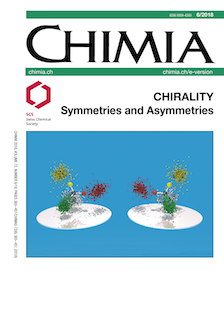Enantiospecific Adsorption and Decomposition of D- and L-Asp Mixtures on Cu(643)R&S
DOI:
https://doi.org/10.2533/chimia.2018.404Keywords:
Adsorption, Amino acids, Chirality, Mechanisms, SurfacesAbstract
The study of molecular chirality is essential to understanding the fundamentals of enantiospecific chemical interactions that are ubiquitous in the biochemistry of life on Earth. At a molecular level, there is insufficient understanding of chiral recognition and enantiomer–enantiomer interaction (aggregation) of chiral molecules adsorbed on surfaces. Here, using enantiospecific isotopic labelling and surface sensitive techniques, we show that when the two enantiomers of chiral aspartic acid (Asp) are adsorbed on the naturally chiral Cu(643)R&S surfaces, they decompose enantiospecifically depending on the chirality of the surface. The non-linear kinetics of the surface decomposition mechanism amplifies the difference between the decomposition rate constants of the two adsorbed enantiomers resulting in highly enantiospecific decomposition rates. Further, we also demonstrate that Asp enantiomers aggregate homochirally on several chiral and achiral surfaces, amplifying the enantiomeric excess on the surface with respect to that in the gas phase, |ees |>|eeg. Our results show that it is possible to discern the enantiospecific behavior of a complex adsorbate such as Asp and shed light on molecular level enantiospecific interactions on surfaces. The enantiospecific isotope labelling methods discussed in this paper allow probing of both the qualitative features of the Asp decomposition mechanism on Cu(643)R&S and quantitative aspects of the adsorption equilibria of enantiomer mixtures.Downloads
Published
2018-06-27
How to Cite
[1]
S. Dutta, A. J. Gellman, Chimia 2018, 72, 404, DOI: 10.2533/chimia.2018.404.
Issue
Section
Scientific Articles
License
Copyright (c) 2018 Swiss Chemical Society

This work is licensed under a Creative Commons Attribution-NonCommercial 4.0 International License.







